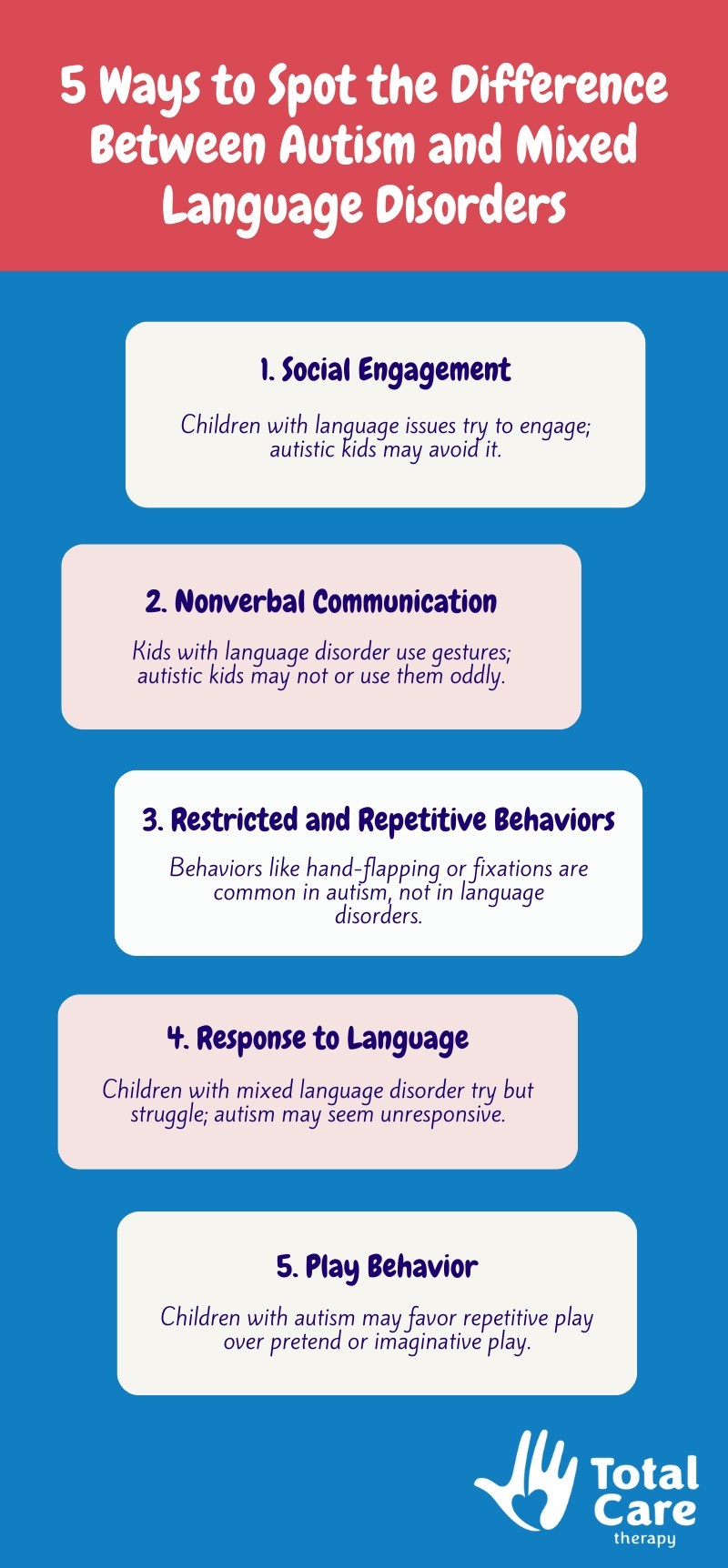Mixed Receptive Expressive Language Disorder vs Autism: How to Tell
Mixed receptive expressive language disorder vs autism—understand the overlapping signs and how to tell the difference with expert tips.
Mixed Receptive Expressive Language Disorder vs Autism: How to Tell
Key Points:
- Mixed receptive expressive language disorder and autism can both affect communication, but their root causes and characteristics differ.
- Observing how a child interacts socially, responds to language, and uses nonverbal cues can help differentiate between the two.
- ABA therapy can support children with either diagnosis, helping them build stronger communication and social skills.
When a child struggles with speech, communication, or social interaction, the first question on many parents' minds is: What’s going on? Two conditions that frequently come up in these conversations are mixed receptive expressive language disorder and autism spectrum disorder (ASD). But while they can look similar on the surface—especially in young children—they are not the same.
Understanding the difference between mixed receptive expressive language disorder vs autism can help parents get a clearer picture of their child’s needs, and most importantly, determine what kind of support will help them thrive. Let’s take a deeper look into what makes these two conditions distinct, how they overlap, and what to watch for when considering a diagnosis.
What is Mixed Receptive Expressive Language Disorder?
Mixed receptive expressive language disorder is a communication disorder where a child has trouble both understanding (receptive) and using (expressive) spoken language. This isn’t a delay due to lack of exposure or a hearing issue—it’s a genuine developmental challenge.
Children with this disorder may:
- Struggle to follow directions or understand what’s being said to them.
- Speak in short or incomplete sentences.
- Have trouble finding the right words or using correct grammar.
- Repeat phrases without fully understanding them.
This disorder is rooted specifically in language processing. It doesn't typically affect nonverbal communication (like gestures, facial expressions, or emotional reciprocity), and most children with it are eager to interact socially.
What is Autism Spectrum Disorder?
Autism is a neurodevelopmental condition that impacts how a person communicates, relates to others, and experiences the world. It’s much broader in scope than a language disorder, involving social skills, sensory processing, behavior patterns, and more.
Some common signs of autism include:
- Delayed or absent speech, or unusual speech patterns (like echolalia).
- Limited eye contact or difficulty reading social cues.
- Restricted interests or repetitive behaviors.
- Challenges with transitions or changes in routine.
- Sensory sensitivities (e.g., covering ears, avoiding certain textures).
While language delay is often one of the early red flags for autism, it’s only one piece of a much larger puzzle.
Mixed Receptive Expressive Language Disorder vs Autism: 5 Core Differences
Parents often wonder, Is my child just a late talker? Or is something more going on?
Let’s look at key differences that may help distinguish mixed receptive expressive language disorder vs autism.

Signs That Might Point Toward One vs the Other
While no single checklist can replace a comprehensive evaluation, here are some detailed differences to help guide your observations:
Signs That Suggest Mixed Receptive Expressive Language Disorder
- The child makes eye contact and enjoys social attention.
- They gesture, point, or use facial expressions.
- Play is age-appropriate and imaginative.
- Delays are mainly in spoken language, with few other developmental concerns.
- They show frustration when misunderstood or unable to speak.
Signs That Suggest Autism Spectrum Disorder
- The child avoids social interaction or seems uninterested in others.
- Limited use of gestures or facial expressions.
- Repetitive behaviors or insistence on sameness.
- Unusual reactions to sensory input (covering ears, refusing certain textures).
- Language may be delayed, absent, or used in an atypical way (e.g., scripts from TV shows).
What If a Child Has Both?
It's also important to understand that these conditions can co-occur.
Some children have both autism and mixed receptive expressive language disorder. In fact, language delays are common in autism—though the underlying reasons differ.
In these cases, intervention should address both language development and the broader challenges associated with autism. That’s where customized, evidence-based approaches like ABA therapy become incredibly valuable.

When to Seek Help—and What Kind
If you're wondering whether your child’s struggles are due to a language disorder, autism, or both, the next step is a comprehensive evaluation. This might include:
- A developmental screening by your pediatrician.
- An assessment by a speech-language pathologist (SLP).
- A full diagnostic evaluation by a developmental pediatrician or psychologist.
No two children are exactly alike, so gathering detailed information from multiple professionals helps paint a clearer picture.
Once a diagnosis is made—or even before—starting early intervention is key. The brain is most flexible during the early years, and with the right support, many children make meaningful progress in communication, socialization, and daily functioning.
How ABA Therapy Can Help
Whether a child is diagnosed with autism, a mixed language disorder, or both, the goal is the same: help them connect, express themselves, and thrive.
Applied Behavior Analysis (ABA) therapy is one of the most effective, research-based interventions for children with autism. And in some cases, elements of ABA are also used to support children with severe language delays.
ABA focuses on:
- Teaching communication skills (verbal, nonverbal, or augmentative).
- Reinforcing social behaviors like turn-taking and eye contact.
- Reducing behaviors that interfere with learning (e.g., frustration outbursts).
- Encouraging independence in daily routines.
Programs are tailored to the child’s unique needs and strengths, whether they’re working on basic requests or more advanced conversation skills.
Parents are also a critical part of the process—trained to reinforce strategies at home, advocate for their child, and celebrate the small wins along the way.
Final Thoughts: Understanding Your Child’s Needs
When comparing mixed receptive expressive language disorder vs autism, remember—it’s not about labeling your child. It’s about understanding what’s behind their communication challenges so you can help them grow.
If you’ve noticed signs that your child is struggling with speech, language comprehension, or social interaction, you don’t have to wait for a formal diagnosis to start helping. Early support can make all the difference.
At Total Care ABA, we provide personalized, family-centered ABA therapy in Maine, Arizona, Georgia, North Carolina, Utah, Indiana, New Mexico, and Tennessee. If your child has been diagnosed with autism—or if you’re still seeking answers—we’re here to walk this journey with you.
Reach out today to learn how we can help your child find their voice and build meaningful connections.








